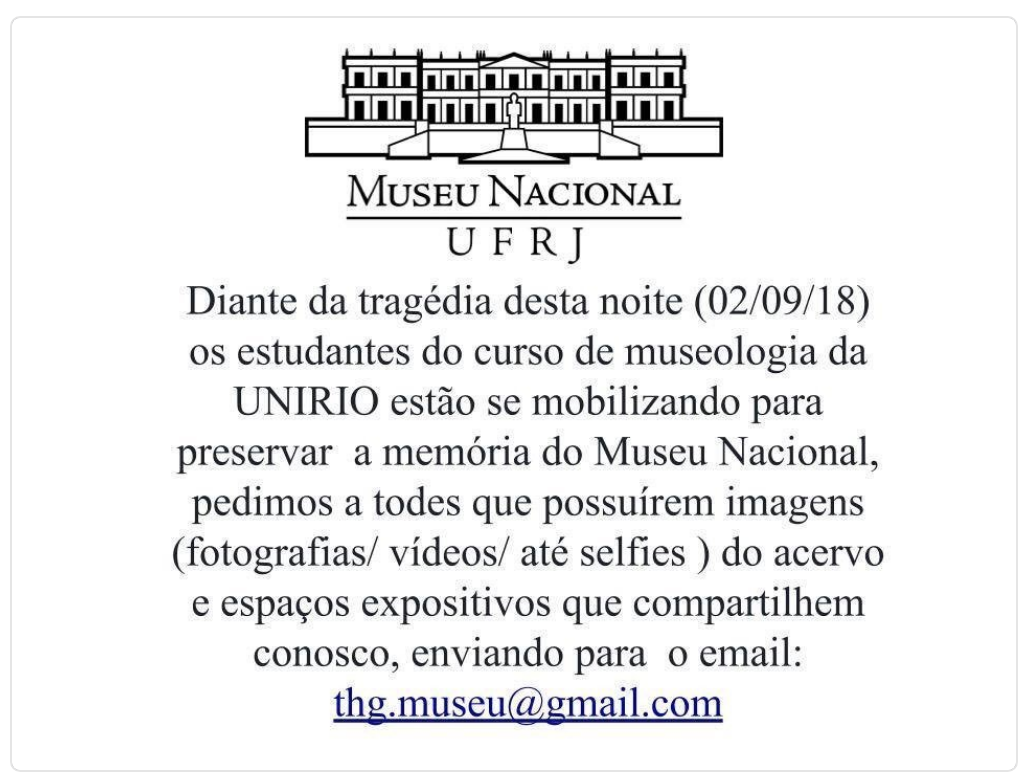 The New York Times described the fire at the National Museum of Brazil as “a new genocide”, recounting how the 20 million documents, artifacts, and artwork were eaten by flames, forever eliminating the only records of now-extinct cultures. But that is not exactly one hundred percent true… What still exists are tourists’ photographs of the museum.
The New York Times described the fire at the National Museum of Brazil as “a new genocide”, recounting how the 20 million documents, artifacts, and artwork were eaten by flames, forever eliminating the only records of now-extinct cultures. But that is not exactly one hundred percent true… What still exists are tourists’ photographs of the museum.
A genius initiative began only hours after video of the fire was broadcast around the world. The project, started by a group of students, is to collect every photograph of the museum in an effort to recreate what used to be. The request was shared widely via email and Twitter, I posted it on Reddit’s museum and travel forums, and soon, Wikipedia and the New York Times began their own similar collections. If all goes well, there will be at least one photograph of every single item on display plus images of accompanying labels.
What’s remarkable though, is that the request specifically mentions selfies. The rationale is not to gather visitor data but instead to look past the smiling faces and into the photographs’ backgrounds for clues about the museum’s exhibitions. No one could have imagined that when their open photography policy was enacted, that this might be its best (and even only) chance at preservation.
Earlier this week in Brussels, six thousand miles away from Rio de Janeiro, the ability to take and post photographs in and of public places in Europe has been all but eliminated.
Activist Cory Doctorow explains:
“… Members of the European Parliament adopted every terrible proposal in the new Copyright Directive and rejected every good one, setting the stage for mass, automated surveillance and arbitrary censorship of the internet: text messages like tweets and Facebook updates; photos; videos; audio; software code — any and all media that can be copyrighted.”
The new ruling is expansive and includes:
- Nearly every platform has to defensively adopt copyright filters that examine everything you post and censor anything judged to be infringement.
- Linking to news using two or more words from an article is prohibited, unless you or the service you’re using bought a license from that source.
- Photographs of public spaces that include copyrighted work (stock art in ads, logos on t-shirts) are not protected by the “freedom of panorama”.
- User-generated content is not exempt, meaning that there is no exception for “criticism, review, illustration, caricature, parody or pastiche.”
But where do these rules leave us, the museums and cultural institutions?
On the assumption that these rules are formally adopted across Europe (they still need to work out some details and language), there will be consequences for breaking them. And it is not unreasonable to assume that the penalties will be strong and unsurmountable by the average person.
Therefore, we can presume that many people might just stop taking and sharing photographs in fear of how they will trigger the filters put in place to eliminate copyright infringement. Put simply, why risk taking a selfie with your favorite artifact when the consequences could be financially burdensome? Or why bother posing next to your art doppelgänger if the resulting photograph inadvertently includes a person near you with a logo on their shirt? If the “freedom of panorama” isn’t going to be protective, did the artselfie, museumselfie and travelselfie just die before our eyes? Is it a reasonable assumption that even if you have signage saying photography is allowed that visitors will parse through the complex legal text that conveys this information?

Which brings us back to Brazil.
Even though the building and its artifacts are now just piles of ash, museum selfies survived on the phones and computers of thousands of people. On TripAdvisor, Instagram, Flikr, and Facebook, an entire museum is being systematically pieced back together image by image. Had copyright filters removed every user-generated photograph with possible infringement, the movement to rebuild the history of Brazil might not have been possible at all.
Like with Net Neutrality in the United States, laws and regulations policing the Internet that don’t mention museums or cultural institutes still deeply affect us. The interviews I’ve been conducting as part of my doctoral research have repeatedly proven that the wider museum community, despite awareness of such laws, elect to ignore their effects “until we really need to worry about it”. Because if we do that, we may just find that, in retrospect, we needed those selfies to piece back together our humanity.